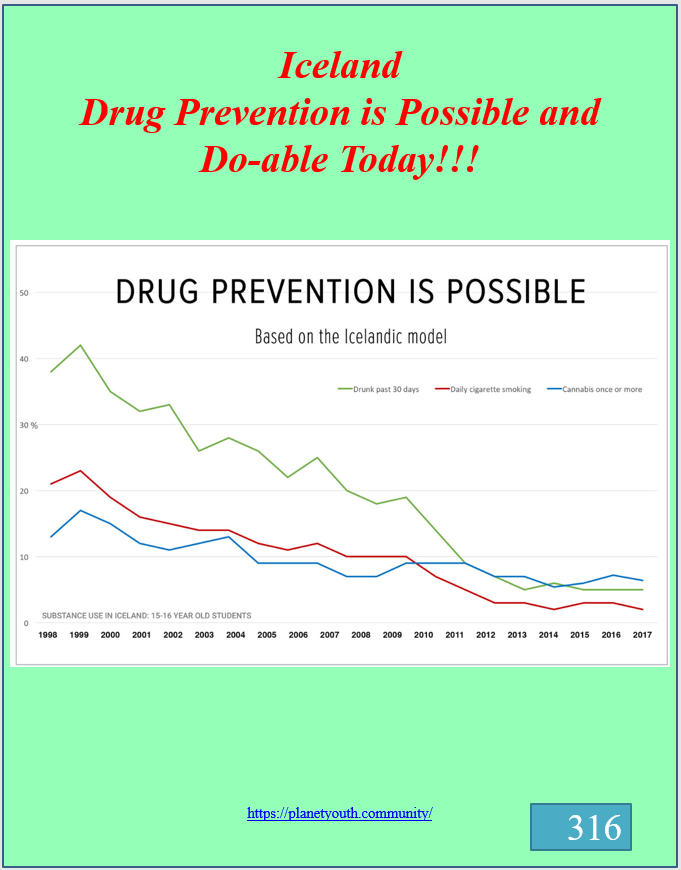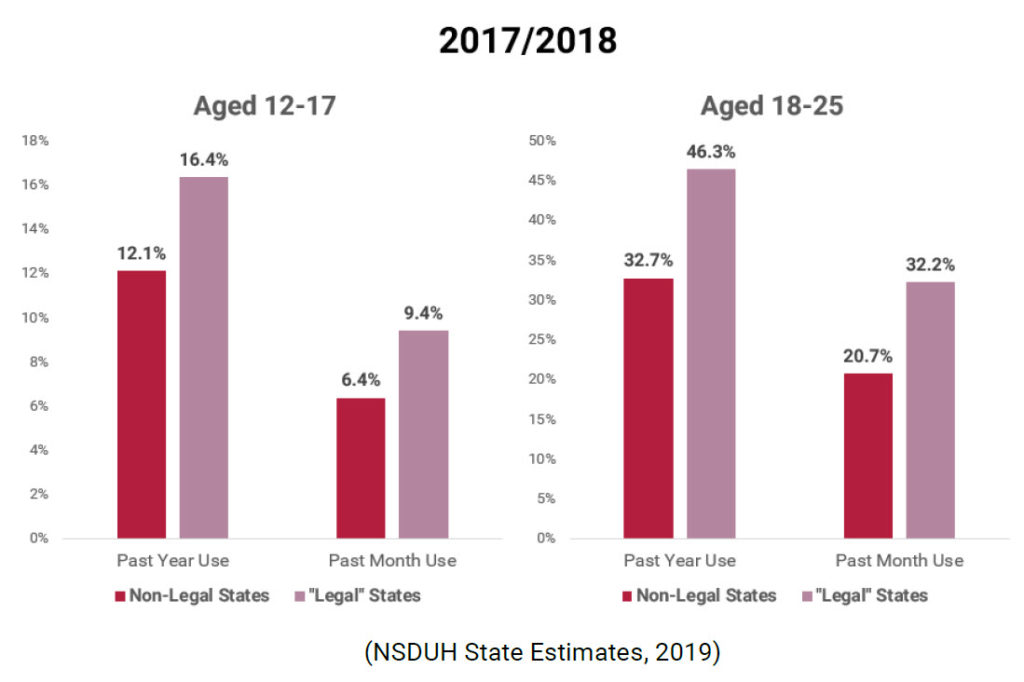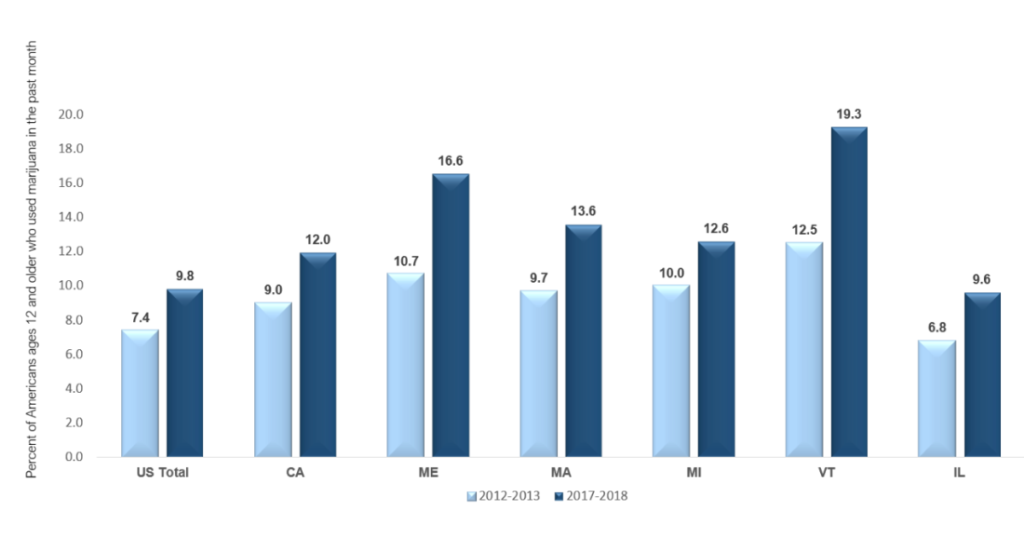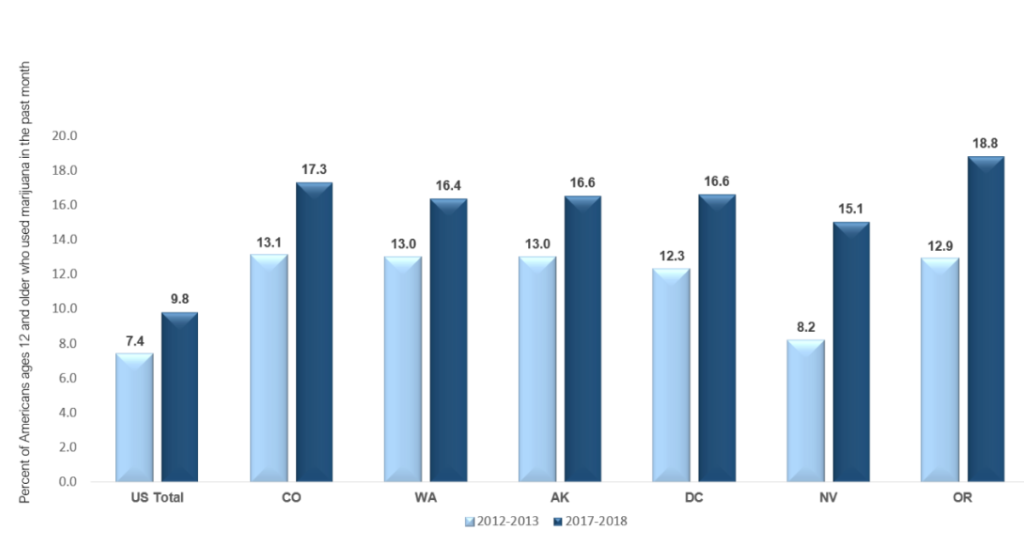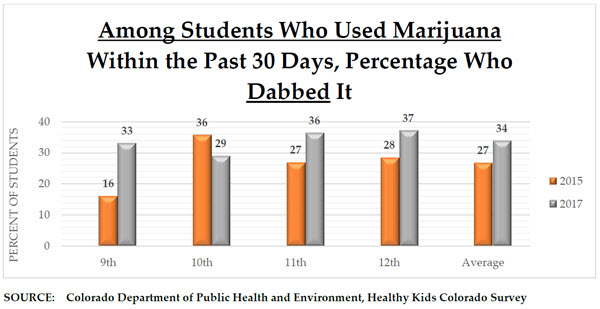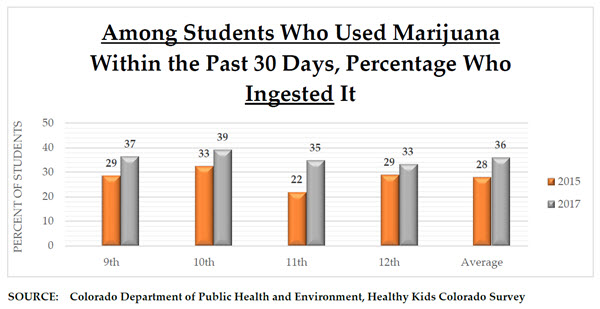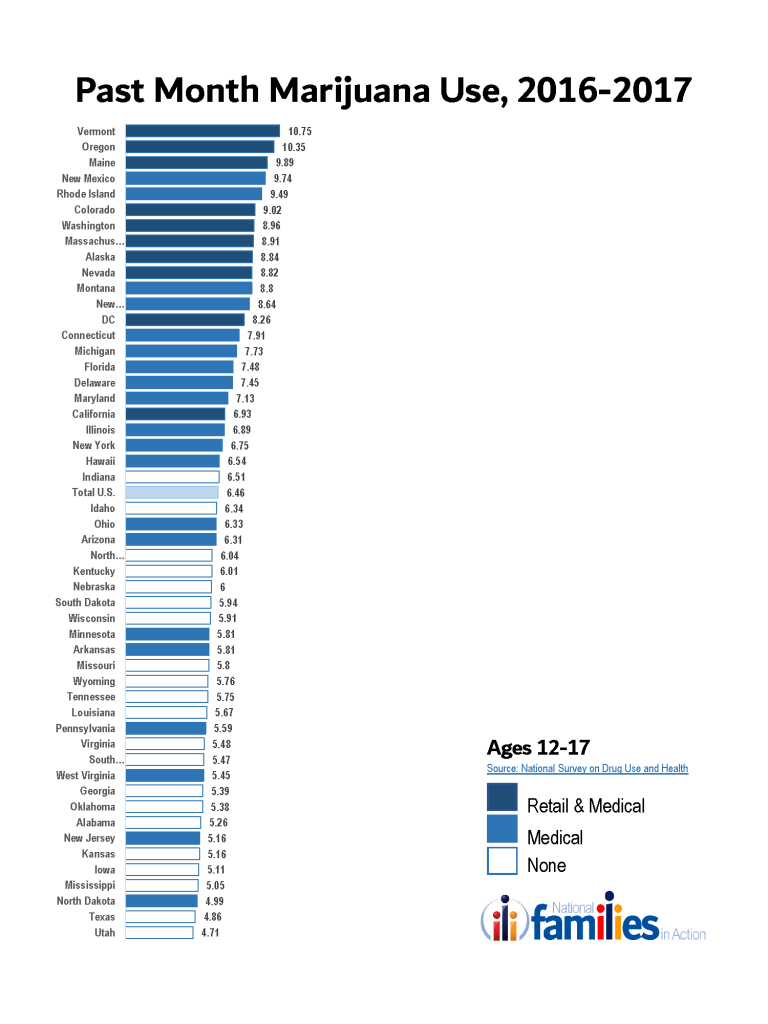LATEST DATA 2020
US state-level data from the National Survey on Drug Use and Health, the most authoritative study on drug use conducted by the Substance Abuse and Mental Health Administration (SAMHSA), has found significant increases in youth cannabis use in several recently legalised marijuana states versus last year. At the same time, mental illness indicators worsened across the country while alcohol, cocaine, and tobacco use dropped, especially among young people.
According to the data, adolescents aged 12-17 using marijuana in the past year significantly increased versus last year in the legalised states of Nevada, Oregon, and California. All other legal states showed increases as well, but versus last year they did not reach statistical levels of significance.
Nevada experienced a 17.4% increase, while Oregon and California witnessed increases of 15.4% and 14.5%, respectively. These increases were not witnessed in non-legal states. In non-legal Virginia and New York, adolescent past year marijuana use significantly fell, as it did in the non-legal Southern region of the United States.
The data additionally show a statistically significant 25.5% increase in past-month use in California among those aged 12-17.
The data also show us that youth use in states that have “legalised” marijuana far outstrips use in states that have not. Past-month marijuana use among young people aged 12-17 in “legal” states is 54.5% higher than past-month marijuana use among 12-17-year-olds in “non-legal” states (10% versus 6.47%). Past-year marijuana use among this age group in “legal” states is 41% higher than that of 12-17-year-olds in “non-legal” states (17.12% versus 12.14%).
Use among young adults aged 18-25 skyrocketed, especially in legal states.
https://www.samhsa.gov/data/sites/default/files/reports/rpt32806/2019NSDUHsaeShortTermCHG/2019NSDUHsaeShortTermCHG/2019NSDUHsaeShortTermCHG.pdf
Cigarette smoking, which had remained flat after a continued decade-long decline, was offset in 2018 by escalating use of e-cigarettes and marijuana among young adults: E-cigarette use climbed 48%, and marijuana use rose by 19% over one year. (age 18-25). Marijuana users tend to use multiple methods of consumption, with only 22.2% of young adult current users reporting that they use a single method. The many methods of consuming marijuana include smoking, vaporizing, dabbing, eating, or drinking. Dabs contain a higher concentration of marijuana that can be smoked or vaped. Among young adult current marijuana users, 81% reported smoking marijuana with a joint, bong, or pipe, followed by vaping at 47%, use of a blunt at 43%, eating or drinking at 35%, and dabbing at 23%. Preferences by gender are comparable, with the exception that more young women than young men significantly eat/drink marijuana (45% vs. 28%). We also examined preferences of marijuana use by age and found that methods of marijuana use among young adults ages 18-20 are similar to the methods used by those ages 21-25… More than half a million (40%; 527,000) current marijuana users were underage.
https://healthpolicy.ucla.edu/publications/Documents/PDF/2020/Smoking_Landscape_June2020.pdf
LATEST DATA 2019
New research about legal cannabis has revealed a sobering statistic. In states where recreational marijuana has been legalised, teenagers are suffering higher rates of addiction. The study of 505,796 respondents was carried out by researchers from New York University’s School of Medicine. It compared use of the drug before and after legalisation in the US. The proportion of people aged 12 to 17 who reported cannabis use disorder grew from 2.18 percent to 2.72 percent. One of the (other) more solid findings is the actual increase in use and frequent use was in the 26-year-olds and older. It seems to be its more the adult people who would usually transition out of cannabis are now coming back in to the market now that it’s legal. (Newshub Nov 2019)
The Substance Abuse and Mental Health Services Administration (SAMHSA) released the 2017-2018 National Survey on Drug Use and Health (NSDUH) State Estimates in December 2019.
- Past year and past month marijuana use among 12 to 17 year-olds in “legal” states increased around 3.5%, each from 2016-2017 to 2017-2018.
- Past year and past month marijuana use among 18 to 25 year-olds increased nearly 4.4% each from 2016-2017 to 2017-2018
- While 23.8% of 12 to 17 year-olds in non-legal states perceive a risk from smoking marijuana once a month, only 17.4% in “legal” states perceive such a risk
- One study found cases of Cannabis Use Disorder (CUD) in young people in “legal” states grew 25% following legalization (Cerda et. al., 2019).
This year’s data occurs five years after the first states, Colorado and Washington, legalised marijuana for recreational use. Eleven states have done so now, and below is the past-month marijuana use for people ages 12 and older in the legal states between 2012-2013 and 2017-2018.
The data above is backed up by the most recent research published in the journal JAMA Psychiatry in November 2019 found that the climb in conditions like cannabis use disorder are “a potential public health concern.” The researchers looked at surveys completed by 505,796 people between 2008 to 2016. The team looked at data on states where cannabis had been legalized by 2016—Colorado,Washington, Alaska, and Oregon— and noted if and how often respondents used marijuana in the past month, and whether they had cannabis use disorder before and after the laws were enacted. In adults aged 26 or older, the number who said they had used cannabis in the past month rose by 23 percent when compared with states where recreational use isn’t allowed. Problematic cannabis use rose by 37 percent, from 0.90 percent to 1.23 percent, after recreational marijuana legalization. The number of respondents aged between 12 to 17-years-old who had cannabis use disorder rose “slightly” by 25 percent compared with those in the same group in other states, from 2.18 percent to 2.72 percent, the authors wrote. But among participants aged between 18 to 25-years-old, the rates of cannabis use in the past month, frequency and cannabis use disorder didn’t change.
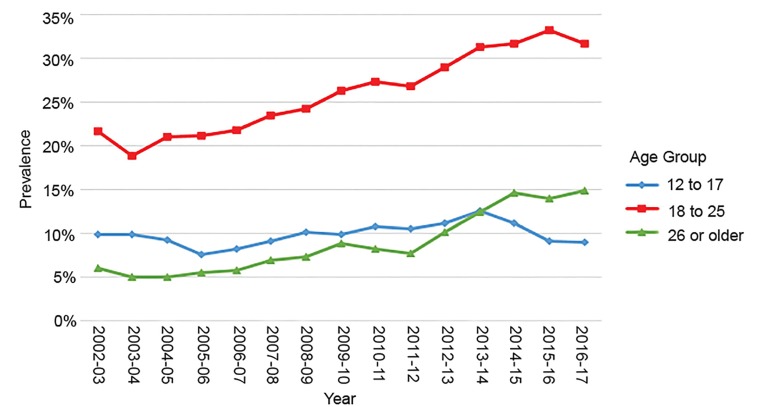
Marijuana use in the past month in Colorado, by age group. Reproduced from Substance Abuse and Mental Health Services Administration National Survey on Drug Use and Health: State Estimates. Available at: https://pdas.samhsa.gov/saes/state. Accessed November 2018. https://www.ncbi.nlm.nih.gov/pmc/articles/PMC6625695/
The Substance Abuse and Mental Health Services Administration released the 2018 Annual National Survey on Drug Use and Health (NSDUH), the most comprehensive survey on drug use. According to the survey, 45,000 more teenagers are regularly using the drug, marijuana users are more likely to abuse opioids than non-users, and levels of marijuana use disorder continue to rise. According to the study, an average of 8,400 Americans aged 12 or older tried marijuana for the first time each day in 2018. This is an increase of 100 users per day from last year’s study. Furthermore, the majority of people in 2018 who reported first time marijuana use were between the ages of 12-25.
According to NSDUH data, in all jurisdictions with legalized recreational marijuana (Alaska, California, Colorado, the District of Columbia, Maine, Massachusetts, Michigan, Nevada, Oregon, Vermont, though only personal use and growing is legal there, and Washington), past-month drug use among youth aged 12-17 continues to sit above the national average (NSDUH, 2016-2017). Colorado, where recreational marijuana has been legal since 2012, has the highest rate of first-time marijuana use among youth (ages 12-17) and young adults (ages 18-25) (NSDUH State Estimates, 2016-2017).
The percentage of youth aged 12-17 years old using marijuana is declining in states where marijuana is not “legal,” unlike in “legal” states; in 2016/2017, the rate of past month 12-17-year-old marijuana use in “legal” states was 7.7%, versus 6.2% in non-legal states.1 (NSDUH State Reports 2016-2017). [Figure 2] The national rate of 18-to-25-year-old past month marijuana use is 21.5%. The rate for “legal” states, however, is much higher — 29.2%. The rate in non-legal states is close to the national average, standing at 20.8% (NSDUH, 2016-2017). Additionally, one recent study showed that longer duration of legalization and higher dispensary density was associated with increased use of vaping and edibles by 14-18-year-olds (Borodovsky, et al., 2017). Source: SAM
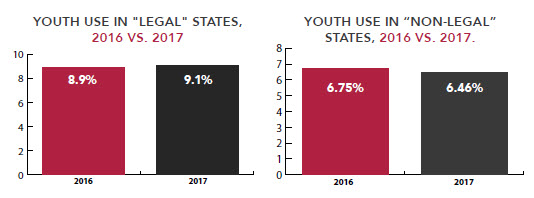
Often overlooked, the percentage of young adults (18-25-year-olds) reporting past-month marijuana use increased between 2015/2016 and 2016/2017 at a higher rate in “legal” states versus non-legal ones (NSDUH, 2016-2017). The national rate of 18-to-25-year-old past month marijuana use is 21.5%, while the rate for “legal” states is much higher – 29.2%. The rate in non-legal states is close to the national average, standing at 20.8% (NSDUH, 2016-2017). Source: SAM
COLORADO (Sep 2019)
- overall, past-month marijuana use for all ages 12 and older increased 58% and is 78% higher than the national average
- adult use has increased 94% (96% higher than the national average)
- college age marijuana use increased 18% and is 48% higher than the national average
- youth marijuana use decreased 14% but is still 40% higher than the national average. First time use in Colorado ranks highest in the USA for 12-17 and 18-25 age groups. There is also a concerning increase in the use of high-THC dabbing and edibles amongst young teenagers
(Rocky Mountain High Intensity Drug Trafficking Area 2019)
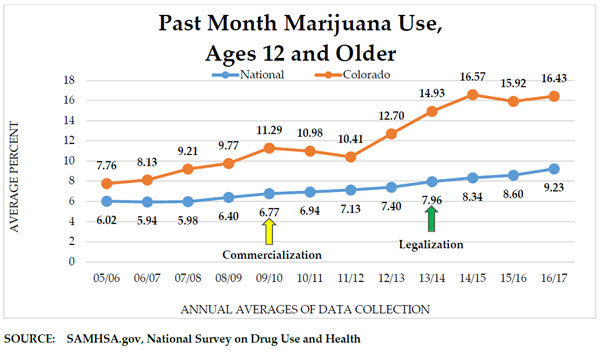
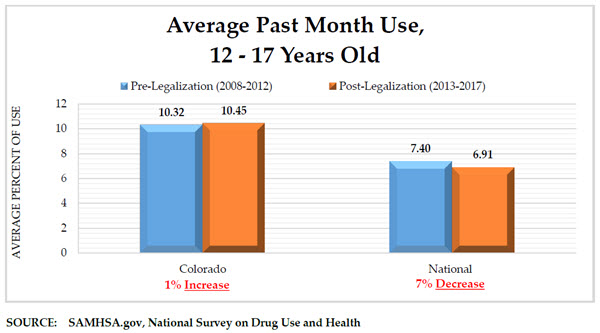
AND EVEN IN PORTUGAL
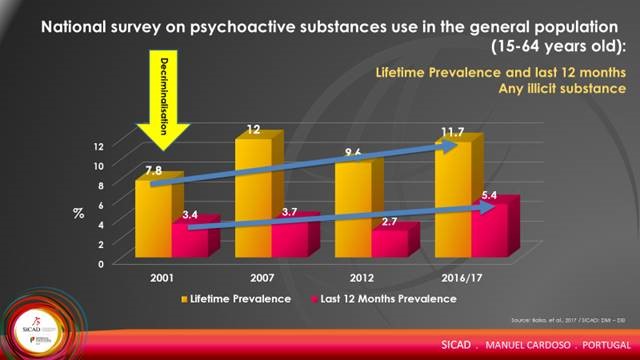
YOUTH USE!
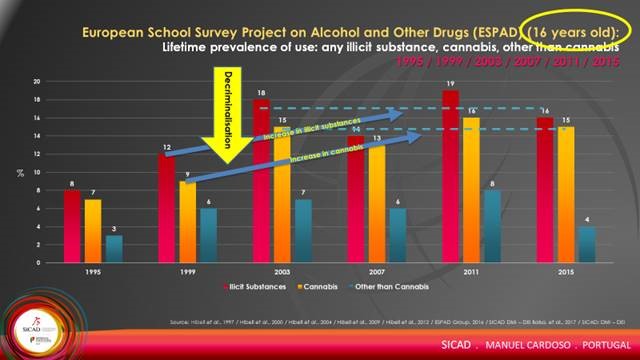
Contrast that with Iceland – where drugs are still illegal.
